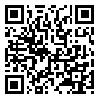BibTeX | RIS | EndNote | Medlars | ProCite | Reference Manager | RefWorks
Send citation to:
URL: http://mlj.goums.ac.ir/article-1-80-en.html
Abstract Background and objectives: Despite prenatal care, pre-eclampsia is still one of the most important causes of maternal and fetal mortality. There is no screening test for pre-eclampsia to be reliable and economical. One of the most accessible and easiest screening tests is blood uric acid measurement. The goal of this study is to assess the level of uric acid in high risk pregnant women a few weeks before emerging the manifestations of pre- eclampsia. Materials& Methods: In this study carried out in Isfahan medical centers, 124 pregnant women with gestational age of 24-28 weeks were selected by simple non-probability sampling. Then the subjects' uric acid were measured and considered high if it would be more than 4.5mg/dl. Results: of all the subjects, only 20 (16.1%) suffered from preeclampsia. 10 of 39(31.4%) who had high uric acid(more than 4.5mg/dl) showed pre-eclampsia.It is true for low uric acid women(68.6%), that is , the number of pre-eclampsia was ten. Conclusion: Relative risk of increased level of uric acid in preeclampsia at 24-28 weeks of gestational age was 2.2. Chi-square test showed that there is significant difference between the level of uric acid at 24-28 weeks of gestational age and the Incidence of preeclampsia. Keywords: pre-eclampsia, uric acid- high risk pregnancy
Received: 2011/09/5 | Accepted: 2013/05/26 | Published: 2013/05/26 | ePublished: 2013/05/26
| Rights and permissions | |
 |
This work is licensed under a Creative Commons Attribution-NonCommercial 4.0 International License. |

This work is licensed under a Creative Commons Attribution-NonCommercial 4.0 International License.






